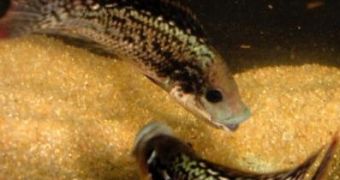The penis is a gift of evolution. At least in the case of fish, in which most species have an external fecundation (like we see in most frogs and toads), and a penis would be useless. (the sole exception are sharks, rays, and species of Poeciliidae family and related groups, tiny tropical species, some very common in fish tanks, like gupy, molly, platy, swordtail).
But some fish need to have complete oral sex. And they can do it even without the penis. Male cichlid fish have got a gene that fools females so that the male can deposit sperm in her mouth.
The new research published in the open access journal BMC Biology has detected a gene connected to egg-like spots on the male's fins, the main factor ensuring male's oral mating.
The team Konstanz University in Germany investigated 19 cichlid species with the purpose of detecting the gene inducing the development of yellow pigment cells in oval spots on the male's fins. The spots are called egg-dummies and are located on male's anal fins.
Most cichlids are called maternal mouthbrooders, because female picks up the laid eggs, protecting them in her mouth till hatching and after that, even the hatchlings for a time. The females mistake as real eggs the egg-dummy patterns approaching the male. When she's close to his anal fin, the male ejaculates into the female's mouth fertilizing the eggs.
Cichlids form a large family of freshwater tropical fish from South America, Africa and India, including tilapia and many tank fish, like angel fish and discus. Hundreds of species are encountered only in East Africa, over 80% being haplochromines, which display the egg dummies. The gene behind the pigment spot of egg-dummies was named the colony-stimulating factor 1 receptor a (or csf1ra).
The same gene was found to produce the egg-dummies on non-haplochromine cichlid spesies, in which the pattern appears rather on the pectoral fins, not the anal ones. "The two kinds of independently evolved egg-dummies serve as a model system to test whether the same genetic pathways are involved in the morphogenesis of both types of dummies", the researchers further explained.

 14 DAY TRIAL //
14 DAY TRIAL //